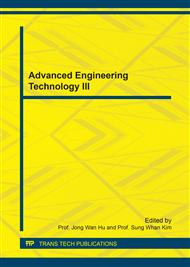[1]
Y. X. Wang, et al., Robust DC/DC converter control for polymer electrolyte membrane fuel cell application. J. Power Sources, 261 (2014) 292-305.
DOI: 10.1016/j.jpowsour.2014.03.048
Google Scholar
[2]
J. Xiao, et al., A 4-μa quiescent-current dual-mode digitally controlled buck converter IC for cellular phone applications. IEEE J. Solid-State Circ. 39(12) (2005) 2342-2348.
DOI: 10.1109/jssc.2004.836353
Google Scholar
[3]
G. R. Walker, P. C. Sernia, Cascaded DC-DC converter connection of photovoltaic modules. IEEE Trans. Power Electr. 19(4) (2004) 1130-1139.
DOI: 10.1109/tpel.2004.830090
Google Scholar
[4]
X. Qu, S. C. Wong, C. K. Tse, Resonance Assisted Buck Converter for Offline Driving of Power LED Replacement Lamps. Trans. China Electrotech. Soc. 26(2) (2012) 532-540.
DOI: 10.1109/tpel.2010.2065242
Google Scholar
[5]
T. K. Nizami, A. Chakravarty, C. Mahanta, Design and implementation of a neuro-adaptive backstepping controller for buck converter fed PMDC-motor. Contr. Eng. Pract. 58 (2017) 79-87.
DOI: 10.1016/j.conengprac.2016.10.002
Google Scholar
[6]
K. H. Liu, Buck converter LED driver circuit. 2010, US.
Google Scholar
[7]
W. R. Liou, M. L. Yeh, Y. L. Kuo, A High Efficiency Dual-Mode Buck Converter IC For Portable Applications. IEEE Trans. Power Electr. 23(2) (2007) 1011-1015.
DOI: 10.1109/tpel.2007.915047
Google Scholar
[8]
H. Kitanaka, Bidirectional buck boost DC-DC converter, railway coach drive control system, and railway feeder system. 2010, US.
Google Scholar
[9]
D. K. Fulwani, S. Singh, Stabilization of a Buck Converter Feeding a Mixed Load Using SMC. 2017: Springer Singapore.
Google Scholar
[10]
J. X. Wang, et al., Extended state observer-based sliding mode control for PWM-based DC–DC buck power converter systems with mismatched disturbances. (2015).
DOI: 10.1049/iet-cta.2014.0220
Google Scholar
[11]
S. Oucheriah, L. Guo, PWM-Based Adaptive Sliding-Mode Control for Boost DC–DC Converters. IEee Transactions On Industrial Electronics, (2013).
DOI: 10.1109/tie.2012.2203769
Google Scholar
[12]
S. Mariethoz, S. Almer, M. Morari, Optimal control of a two control input buck-boost converter, in Proceedings of the 48th Ieee Conference on Decision and Control, 2009 Held Jointly with the 2009 28th Chinese Control Conference. (2009).
DOI: 10.1109/cdc.2009.5400613
Google Scholar
[13]
M. AmirAskari, M. B. Menhaj. Fuzzy model predictive control based on modified fuzzy relational model. in Fuzzy Systems (IFSC), 2013 13th Iranian Conference on. (2013).
DOI: 10.1109/ifsc.2013.6675679
Google Scholar
[14]
Y. X. Wang, et al. Buck DC-DC converter design and experimental validation by time delay control. in Automatic Control Conference (CACS), 2013 CACS International. (2013).
DOI: 10.1109/cacs.2013.6734190
Google Scholar
[15]
C. Vlad, et al. Explicit model predictive control of buck converter. in Power Electronics and Motion Control Conference (EPE/PEMC), 2012 15th International. (2012).
DOI: 10.1109/epepemc.2012.6397240
Google Scholar
[16]
S. Mariethoz, M. Herceg, M. Kvasnica. Model Predictive Control of buck DC-DC converter with nonlinear inductor. in 2008 11th Workshop on Control and Modeling for Power Electronics. (2008).
DOI: 10.1109/compel.2008.4634700
Google Scholar
[17]
M. Morari, U. Maeder, Nonlinear offset-free model predictive control. (2012).
Google Scholar
[18]
M. Morari, U. Maeder, Nonlinear offset-free model predictive control. Automat. 48(9) (2012) 2059-(2067).
DOI: 10.1016/j.automatica.2012.06.038
Google Scholar
[19]
U. Maeder, F. Borrelli, M. Morari, Linear offset-free Model Predictive Control, Automat. 45(10) (2009) 2214-2222.
DOI: 10.1016/j.automatica.2009.06.005
Google Scholar


